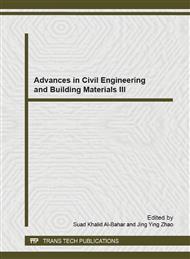p.326
p.331
p.336
p.343
p.348
p.354
p.359
p.364
p.370
Identification of the Dynamic Load Supplied on Top Pier of High Speed Railway Bridge
Abstract:
With the development of railway transportation, the traffic load increased continuously and it had the adverse effect on the system of pier-foundation. The quantitative analysis of the load supplied on the top pier is necessary for analyzing the dynamic response of pier-foundation system. Based on the theory of vibration inverse analysis and finite element method, the paper identified the dynamical load supplied on the top pier in vertical and the transverse direction. Combined with the vibration and acceleration history measured by the field test in Xiaolinhe Bridge, the vertical and transverse direction vibration-load history curves were calculated when the train speeds were 153 km/h and 206 km/h respectively. The results indicated that the amplitude of dynamic load increased with the higher speed of train.
Info:
Periodical:
Pages:
348-353
Citation:
Online since:
December 2013
Authors:
Keywords:
Price:
Сopyright:
© 2014 Trans Tech Publications Ltd. All Rights Reserved
Share:
Citation:


